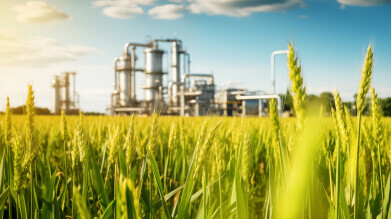Fuel for Thought
New technologies emerge for production of green ammonia
Apr 25 2024
Ammonia (NH3), a compound of nitrogen and hydrogen, is a critical ingredient in agricultural fertilizers and industrial applications. Traditionally, ammonia production, known as the Haber-Bosch process, relies on fossil fuels to generate the necessary hydrogen and power the reaction, contributing significantly to global carbon emissions. In contrast, green ammonia is produced using renewable energy sources and is a more environmentally friendly alternative. It uses water electrolysis to extract hydrogen and air separation to obtain nitrogen. The entire process, powered by renewable energy, avoids the significant carbon footprint associated with traditional ammonia production.
Green ammonia's potential applications extend beyond its traditional use as a fertilizer. Ammonia can be stored as a liquid under moderate pressure or refrigerated conditions, making it an excellent medium for storing renewable energy - and it can function as a carrier for hydrogen, offering a more manageable solution for storing and transporting hydrogen. When burnt, ammonia produces only water and nitrogen, posing as a clean alternative fuel, particularly for the maritime industry.
The production of green ammonia utilizes innovative methods to minimize environmental impact. Electrolysis is a method in which electricity from renewable sources is used to split water into hydrogen and oxygen, which are then synthesized into ammonia. In another method, nitrogen is separated from the air and combined with hydrogen in the Haber process, all powered by sustainable electricity sources. Companies are exploring technologies that reduce the scale of production facilities, potentially allowing ammonia synthesis using modular systems housed in shipping containers. These compact systems are designed for local use, reducing transportation emissions.
While the technology for producing green ammonia is promising, significant challenges remain. Scaling up production to meet global demand will require substantial investment in new infrastructure. Ammonia's toxicity poses safety risks in handling and transport, necessitating robust safety protocols. Although the cost of producing green ammonia is dropping with renewable energy prices, it remains more expensive than traditional methods, hindering widespread adoption.
As the world moves towards net-zero carbon emissions, green ammonia stands out as a pivotal technology. It can significantly reduce the carbon footprint of the agricultural sector and serve as a clean fuel alternative, particularly in industries hard to decarbonize like shipping and heavy manufacturing.
Organizations like the World Economic Forum's First Mover Coalition are actively promoting the adoption of green ammonia to reduce carbon emissions across various sectors. With continued innovation and investment, green ammonia has the potential to play a crucial role in achieving global sustainability goals, demonstrating a shift from high-emission ammonia production to a cleaner, more sustainable process.
Digital Edition
PIN 25.2 Apr/May
April 2024
In this Edition Safety - Carbon monoxide toxic and flammable gas detection Analytical Instrumentation - Density: A fundamental parameter at critical stages within the petroleum sector...
View all digital editions
Events
May 06 2024 Riyadh, Saudi Arabia
May 06 2024 Houston, Tx, USA
May 06 2024 Houston, Tx, USA
Canada Gas & LNG Exhibition & Conference
May 07 2024 Vancouver, BC, Canada
May 08 2024 Lahore, Pakistan


















